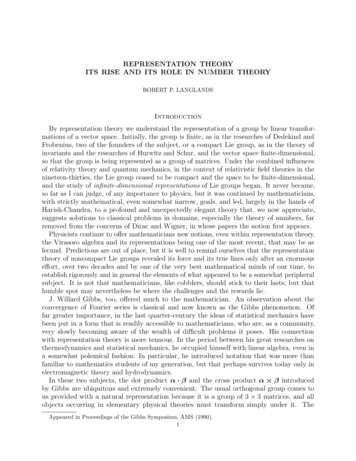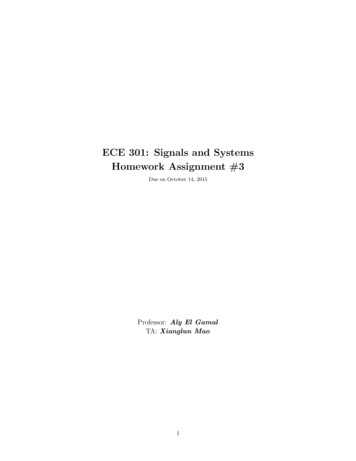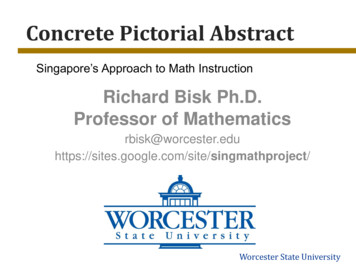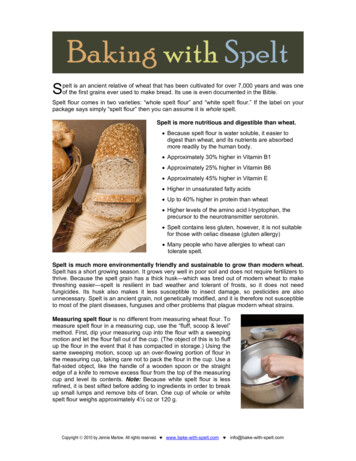
Transcription
REPRESENTATION THEORYITS RISE AND ITS ROLE IN NUMBER THEORYROBERT P. LANGLANDSIntroductionBy representation theory we understand the representation of a group by linear transformations of a vector space. Initially, the group is finite, as in the researches of Dedekind andFrobenius, two of the founders of the subject, or a compact Lie group, as in the theory ofinvariants and the researches of Hurwitz and Schur, and the vector space finite-dimensional,so that the group is being represented as a group of matrices. Under the combined influencesof relativity theory and quantum mechanics, in the context of relativistic field theories in thenineteen-thirties, the Lie group ceased to be compact and the space to be finite-dimensional,and the study of infinite-dimensional representations of Lie groups began. It never became,so far as I can judge, of any importance to physics, but it was continued by mathematicians,with strictly mathematical, even somewhat narrow, goals, and led, largely in the hands ofHarish-Chandra, to a profound and unexpectedly elegant theory that, we now appreciate,suggests solutions to classical problems in domains, especially the theory of numbers, farremoved from the concerns of Dirac and Wigner, in whose papers the notion first appears.Physicists continue to offer mathematicians new notions, even within representation theory,the Virasoro algebra and its representations being one of the most recent, that may be asfecund. Predictions are out of place, but it is well to remind ourselves that the representationtheory of noncompact Lie groups revealed its force and its true lines only after an enormouseffort, over two decades and by one of the very best mathematical minds of our time, toestablish rigorously and in general the elements of what appeared to be a somewhat peripheralsubject. It is not that mathematicians, like cobblers, should stick to their lasts; but thathumble spot may nevertheless be where the challenges and the rewards lie.J. Willard Gibbs, too, offered much to the mathematician. An observation about theconvergence of Fourier series is classical and now known as the Gibbs phenomenon. Offar greater importance, in the last quarter-century the ideas of statistical mechanics havebeen put in a form that is readily accessible to mathematicians, who are, as a community,very slowly becoming aware of the wealth of difficult problems it poses. His connectionwith representation theory is more tenuous. In the period between his great researches onthermodynamics and statistical mechanics, he occupied himself with linear algebra, even ina somewhat polemical fashion. In particular, he introduced notation that was more thanfamiliar to mathematics students of my generation, but that perhaps survives today only inelectromagnetic theory and hydrodynamics.In these two subjects, the dot product α · β and the cross product α β introducedby Gibbs are ubiquitous and extremely convenient. The usual orthogonal group comes tous provided with a natural representation because it is a group of 3 3 matrices, and allobjects occurring in elementary physical theories must transform simply under it. TheAppeared in Proceedings of the Gibbs Symposium, AMS (1990).1
2ROBERT P. LANGLANDStwo products of Gibbs appear because the tensor product of this natural representationwith itself is reducible and contains as subrepresentations both the trivial representation,which assigns 1 to every group element, and, if attention is confined to proper rotations, thenatural representation itself. Tensor products play an even more important role, implicitly orexplicitly, in spectroscopy, and it is their explicit use for the addition of angular momenta,especially by Wigner, that drew representation theory so prominently to the attention ofphysicists.The use of compact groups and their Lie algebras became more and more common, especiallyin the classification of elementary particles, often with great success, as a terminologypeppered with arcane terms from occidental literature and oriental philosophy attests, but theinvestigation of the representations of groups like the Lorentz group, in which time introducesa noncompact element, was left by and large to mathematicians. To understand where it ledthem, we first review some problems from number theory.Number TheoryTwo of the most immediate and most elementary aspects of number theory that are yetat the same time the most charged with possibilities are diophantine equations and primenumbers. Diophantine equations are equations with integral coefficients to which integralsolutions are sought. A simple example is the equation appearing in the pythagorean theorem,(a)x2 y 2 z 2 ,with the classic solutions,32 42 52 ,52 122 132 ,that were in my youth still a common tool of carpenters2,3 and surveyors. It is also possibleto study the solutions of equations in fractions and to allow the coefficients of the equationsto be fractions, and that often amounts to the same thing. If a x/z and b y/z then theequation (a) becomesa2 b2 1.Prime numbers are, of course, those like 2, 3, 5 that appear in the factorization of othernumbers, 6 2 · 3 or 20 2 · 2 · 5, but that do not themselves factor. They do not appearin our lives in the homely way that simple solutions of diophantine equations once did, buttheir use in cryptography, in for example public-key cryptosystems, has perhaps made themmore a subject of common parlance than they once were.The two topics may be combined in the subject of congruences. Consider the equationx2 1 0. If p is any prime number we may introduce the congruence,x2 1 0(mod p).
REPRESENTATION THEORYITS RISE AND ITS ROLE IN NUMBER THEORY3A solution of this is an integer x such that x2 1 is divisible by p. Thus,x 1,x 2,12 1 2 022 1 5 0(mod 2),(mod 5),2x 3,3 1 10 0 (mod 2, mod 5),x 4,42 1 17 0x 5,52 1 26 0 (mod 2, mod 13),x 6,62 1 37 0(mod 17),(mod 37).The list can be continued and the regularity that is already incipient continues with it. Theprimes for which the congruence can be solved are 2 and 5, 13, 17, . . . all of which leave theremainder 1 upon division by 4, whereas primes like 7, 19, 23, . . . that leave the remainder 3upon division by 4 and that have not yet appeared never do so; the congruence is not solvablefor them.This regularity, at first blush so simple, is the germ of one of the major branches of thehigher number theory and was the central theme of a development that began with Euler andLegendre in the eighteenth century, and continued down to our own time, with contributionsby Gauss, Kummer, Hilbert, Takagi, and Artin. Current efforts to extend it will be the themeof this essay.We shall be concerned with more complex congruences, involving, for example, twounknowns and our concern will be strictly mathematical, but I mention in passing thatthese more abstruse topics may also impinge on our daily life, even disagreeably, since thesophisticated theory of congruences modulo a prime is exploited in coding theory and thus inthe transmission of information (and of misinformation, not to speak of unsolicited soundsand images that are simply unpleasant). It is sometimes also necessary, and even important,to consider congruences modulo integers that are not prime, not only for strictly theoreticalpurposes but also for ends that may be regarded as more practical. The difference betweencongruences modulo primes and modulo composite numbers is great enough that it may beused to very good effect in the testing of numbers for primality, and so can be exploited incryptography.Zeta-functionsThe most familiar of the zeta-functions, and the one that has given its name to the others,is that to which the name of Riemann is attached, X1ζ(s) nsn 1 1 1 1 1 1 11 s1 s··· 1 s235Y 1 1 p1spThe equality, due to Euler, is obtained by applying the expansion1 1 x x2 x3 · · ·1 x
4ROBERT P. LANGLANDSto11 p1sto obtain11 2s · · · ,sppand then recalling that every positive integer can be written in one and only one way as aproduct of prime powers.The principal use of the Riemann zeta-function is for the study of the distribution of theprimes amongst the integers. Observing that the sum111 s s ···23behaves like the integralZ 1ds,xs1we conclude correctly that the series defining the zeta-function converges for s 1. To use itto any effect in the study of the distribution of primes it is, however, necessary to define andcalculate it for other values of s.There are manifold ways to do this. The Γ-function, defined by the integralZ Γ(s) e t ts 1 dt1 0when s 0, is readily shown upon an integration by parts to satisfy the relation Γ(s) (s 1)Γ(s 1). It can therefore be defined and its value calculated for any s.To deal with the zeta-function, introduce two further functions defined by infinite series: X2φ(t) e πn t ;n 1θ(t) 1 2φ(t) X2e πn t . Calculating the integral,Z sφ(t)t 2 1 dt,(b)0term by term, we obtainsπ 2 Γ s ζ(s).2As a consequence, to calculate the zeta-function we need only calculate the integral (b) for allvalues of s. The integrand behaves badly at t 0 if s 6 2, so that as it stands the integralstill does not serve our purpose.We next exploit the elements of Fourier analysis, using a device to which Poisson’s name isattached. We observe that θ(t) is the value at x 0 of the periodic function X2e π(n x) t .n
REPRESENTATION THEORYITS RISE AND ITS ROLE IN NUMBER THEORY5It is easy enough to calculate the Fourier expansion of this function. Doing so, and using theexpansion to calculate its value at x 0, we discover that 11(c)θ(t) θ.ttWith this relation in hand we return to the integral (b), replace it by two integrals, one from0 to 1, and one from 1 to . The second is defined for any value of s. In the first, we replaceφ(t) by 1 11 122t 1 t φ.2tThe first two terms yield integrals that can be integrated explicitly, the result being11 ,s 1 swhich gives the anticipated pole at s 1. In the last term, we substitute 1/t for t obtainingan integral from 1 to that is readily seen to converge for any s.Since the function φ(t) decreases so rapidly as t , the two integrals that we have notcalculated explicitly are easily evaluated to any degree of accuracy. This is the main lessonto be drawn from this technical digression. We have not yet linked diophantine equationsto zeta-functions, but when we do, we shall see that as a result of a circle of conjecturesand theorems the use of zeta-functions offers a way of deciding whether a given diophantineequation has a solution that can be thousands of times more effective than even sophisticatedsearches for it. For this, however, it is necessary to be able to calculate their values at certainpoints with precision, although it need not be very great. If our experience in this century isany guide, this can be done only by showing that the zeta-functions attached to diophantineequations are equal to others, defined ultimately in terms of representations of noncompactgroups, that are amenable to the same analysis as the Riemann zeta-function.A classic example, in which the use of infinite-dimensional representations is unnecessary,is provided by the equation x2 1 0. We attach to it the function,111L(s) ··· ,1 ·1 ·1 3s 1 5s 1 71sthe general factor being1,1 p1saccording as the congruencex2 1 0 (mod p)does or does not have a solution. This is a series defined by a diophantine equation. Thenotation L(s) is due to Dirichlet and one often speaks of L-function rather than zeta-function,following conventions that are unimportant here.On the other hand, by the regularity whose importance we have already been at pains tostress, the general factor could also be defined by the alternative that p leave the remainder 1 or the remainder 1 upon division by 4. A Dirichlet character χ is a multiplicativefunction on the integers, thus a function satisfying χ(ab) χ(a)χ(b), and such that χ(a)depends only on the remainder after division of a by some positive integer n. For simplicity,
6ROBERT P. LANGLANDSone customarily takes χ(a) 0 if a and n have a divisor in common. For example a Dirichletcharacter modulo 4 is given by:χ(1) 1;χ(2) 0;χ(3) 1;χ(4) 0.The general factor of the product defining L(s) is then 1χ(p)1 s.pExpanding the product defining L(s) just as we expanded the product for the zeta-functionwe see that1111L(s) 1 s s s s · · ·3579 X χ(n) .snn 0Since the numerator of this series is a periodic function of n we can once again use elementaryFourier analysis to define and calculate L(s) for any s.Because it is so important for the subsequent discussion, I repeat that the function L(s) isoriginally defined by a product of factors determined according to a diophantine alternative,simple though it be. At first glance there is no reason to think that the function has ameaning outside the region, s 1, where the product obviously converges, but thanks to theregularity that we have observed, the product can be converted to a series that is defined bya periodic function and that can be put in a form that has a meaning for any s.We can not expect the regularity always to be so simple; for then it would not have beenso elusive. Two basic classes of examples serve as an introduction to the general problem;both illustrate its difficulty. The first, equations with icosahedral Galois groups, has a greaterhistorical appeal since they are the simplest equations completely inaccessible to the classicaltheory of equations with abelian Galois groups; the solution that appears to be correctfor them was suggested directly by ideas originating in representation theory. The second,equations in two variables defining elliptic curves, illustrates, however, far more cogently to anonspecialist the value of L-functions for diophantine equations and is one of the earliest andmost striking uses of the computer as an aide to pure mathematics; here the solution thatappears to be correct was suggested earlier and on different grounds. Both solutions turn outto be part of the same larger pattern, and although the evidence for them is extensive andoverwhelming, neither has been established in any generality. We begin with equations in asingle variable.Galois groupsIn our discussion of the congruence x2 1 0 (mod p), we emphasized the search forsolutions, but this is tantamount to the search for factorizations,x2 1 x2 2x 1 (x 1)222(mod 2),x 1 x 4 5 (x 2)(x 2)(mod 5).The polynomial x2 1 cannot be factored modulo 7 or 11 or any prime that leaves theremainder 3 upon division by 4, but factors into two linear factors modulo any prime leavingthe remainder 1.
REPRESENTATION THEORYITS RISE AND ITS ROLE IN NUMBER THEORY7Another example, the reasons for whose choice will be explained later, is(d)x5 10x3 10x2 35x 18.It is irreducible modulo p for p 7, 13, 19, 29, 43, 47, 59, . . . and factors into linear factorsmodulo p for p 2063, 2213, 2953, 3631, . . . . These lists can be continued indefinitely, but itis doubtful that even the most perspicacious and experienced mathematician would detectany regularity. It is none the less there.To explain why we have chosen this equation and not another as an example, we firstconsider the general equation in one variable,xn an 1 xn 1 an 2 xn 2 · · · a0 0,in which all coefficients are rational numbers. This equation will have roots θ1 , . . . , θn andthere will be various relations between these roots with coefficients that are also rational,F (θ1 , . . . , θn ) 0.For example, the roots of x3 1 0 are θ1 1, θ2 ( 1 and two of the many valid relations are:θ1 1; 3)/2, θ3 ( 1 3)/2θ2 θ3 θ1 .We can associate to the equation the group of all permutations of its roots that preserve allvalid relations. In the example the sole possibility in addition to the trivial permutation isthe permutation that fixes θ1 and interchanges θ2 and θ3 . This group is extremely important,and is known as the Galois group of the equation. We denote it by G.For simplicity (it is easy to achieve) suppose that the equation has no multiple roots andthat the coefficients are integers, and introduce the discriminant,Y(θi θj ). i6 jIt is an integer and it is fundamental to the theory of diophantine equations that, followingDedekind and Frobenius, we can attach to any prime p that does not divide an element Fpin G that determines among other things how the equation factors modulo p. More precisely,it is the conjugacy class of Fp within the group G that is determined, and that suggests, as isindeed the case, that to define Fp a little theory is necessary.It also suggests the use not of Fp itself but of the trace of the matrix ρ(Fp ), where ρ issome (finite-dimensional) representation of the group G, for the numbers trace(ρ(Fp )) takenfor all ρ determine the class of Fp . We can also, fixing ρ, consider the matrices ρ(Fp ) or,better, their conjugacy classes.Rather than asking how the factorization of the original equation f (x) 0 varies with pand whether it manifests any regularity, we can ask whether, for a given ρ, the conjugacyclasses ρ(Fp ) do. The simplest possibility is that ρ is one-dimensional, and this is the classicaltheory; ρ(Fp ) is then a number that is determined by the remainder left upon division of pby a certain integer n that depends on the equation and on ρ.The next possibility is that ρ is a representation by 2 2 matrices that we may supposeunitary. Recalling the close relation between the group of unitary matrices in two variablesand the group of proper rotations in three variables, the second being a homomorphic imageof the first, we classify finite subgroups of the unitary group by their image in the group ofproper rotations. Taking the finite subgroup to be ρ(G) and excluding the possibility thatρ is reducible, we obtain dihedral, tetrahedral, octahedral, and icosahedral representations.
8ROBERT P. LANGLANDSDihedral representations can be treated by the classical theory; tetrahedral and octahedralrepresentations require modern ideas but have been completely dealt with [L2]. Icosahedralequations, however, remain intractable in general, and even for specific examples verifyingnumerically the validity of the regularity suggested is a task that requires great skill andingenuity and is by no means assured of success.The first step is to find examples of equations with icosahedral Galois groups, and thatrequires a computer search of equations of degree 5. Two possibilities that present themselvesare:x5 10x3 10x2 35x 18 0 ;x5 6x3 12x2 5x 4 0 .It is the first that has been studied closely and not the second, although it has smallercoefficients, so that one might believe calculations with it would be more efficient. A peculiaraspect, however, of the theory of diophantine equations is that a great deal of theory isrequired in order to recognize which are simpler. Neither the size of the coefficients nor theform of the equation is a guide.For equations in one variable there are two criteria: the Galois group and the conductor. Wehave already chosen the Galois group as simple as possible if the equation is to offer difficulties.The conductor is a positive integer related to the discriminant but more complicated. Tocalculate it requires a painstaking examination of the properties of the equation modulopowers, often quite high, of the primes that divide the discriminant, but with enough timeand effort that can always be done. The conductor of the first of our two equations is 800and that of the second 4256. This difference in size entails a great reduction in the numberof calculations, and not being an expert I am not even sure whether the second equation isaccessible to numerical investigations.A good-sized monograph [Bu] was found necessary to explain the methods used to establishthe proposed regularity for the first. This regularity, which is expressed in terms of modularforms, has yet to be described; we have first to establish a conviction that it is necessary,for it is of a transcendental nature, and simply asserts the equality of two quite differentlydefined sequences. The criterion that the statement of regularity has to fulfill in order to beaccepted as significant is analytic. For equations in a single variable, its importance is obscureexcept in a theoretical context like that of Emil Artin’s papers of the nineteen-twenties, inwhich the representation theory of finite groups was fused with the notion of an L-series. Forelliptic curves the importance will be clearer .It is curious that, although one of the two currents that merged in Artin’s papers, representation theory, owed its very existence to Richard Dedekind and F. G. Frobenius [Ha], whoalso contributed essential ideas to the study of L-series and the theory of equations, it is notclear to what extent the rise of representation theory was a response to problems posed byL-series. The correspondence between Dedekind and Frobenius is extant, and the letters ofDedekind have been published [D], but it would be imprudent for a reader inexperienced inthe ways of historical research to read too much into them.If G is the icosahedral group attached to the equation (d) and ρ its two-dimensionalrepresentation, then for all primes p that do not divide the conductor we can form the 2 2
REPRESENTATION THEORYITS RISE AND ITS ROLE IN NUMBER THEORY9matrix ρ(Fp ), which has two eigenvalues, αp and βp . The L-function of Artin is thenY 11L(s) ,αp ·βp1 s1 spppthe primes dividing the conductor being omitted from the product. This product convergesfor s 1 and one of the simplest cases of the problem posed by Artin in 1923 is to show thatas an analytic function of a complex variable it can be defined for all s. For equation (d),this was first achieved in the monograph [Bu] in 1970. It was a critical test of the generalideas formulated in [L1].Elliptic CurvesAs examples of elliptic curves we take the equation in two variables,(e)y 2 x3 Dx,borrowing from the account in a lecture of G. Harder before the Rheinische-WestfälischeAkademie der Wissenschaften [H]. Take D (6577)2 . The equation has the solution x 0,y 0. Does it have further solutions with x and y both rational? One way to attempt toanswer this question is to conduct a computer search.An intelligent search entails an appeal to the theory of the equation, in the hope of replacingx and y by numbers with possibly smaller numerators and denominators. The first step is tosety1 (x21 4D)y2y .x 12 ;4x18x21Then we putx1 lt2 ;y1 lst,and finallyUt ;s lW (2V )2 ;l 6577.2VIf U, V and W are integers satisfying the equationU 4 64V 4 6577W 2 ,then x and y will be rational solutions of the original equation. Further transformations of asimilar nature but with more complex equations are made, and finally, at some point, a moreor less blind search for integers U, V, W satisfying the new equation begins. That takes time,apparently some twenty minutes on an IBM 370 if no false starts are made, and ultimately atriple is found.U 10 500 084 257 375 984 596 799V 1 980 407 963 453 953 023 564W 1 303 262 616 226 128 053 329 966 805 106 514 807 822 601Of course, there is no need except as a mathematical amusement to find solutions tothe equation (e), but the problem of finding some method more efficient than promiscuoussearching to decide whether it has a solution has an immediate appeal that needs no furtherjustification. That such a method may exist is, nevertheless, an astonishing discovery due toBryan Birch and Peter Swinnerton-Dyer [BSD], one of the earliest uses of the computer inpure mathematics and perhaps still that with the deepest implications.
10ROBERT P. LANGLANDSTheir investigations were partly inspired by the study of congruence zeta-functions, whichalso originated with Dedekind and Artin but whose evolution was strongly determined bythe geometrical and topological ideas that infused the mathematics of the middle decades ofthis century. More than anything else, it is these functions that have shaped current numbertheory.As a simple example we take D 1 in equation (e) and then for each prime number p,except 2 and 3, we count the number of solutions modulo p. For example, if p 5 we simplylist the possibilities for x and y and substitute them in the equation to see if it is satisfiedmodulo p.y\x012340 1 2 3 4 The plus sign indicates that the congruence is satisfied and the minus sign that it is not.There are seven plus signs so that the number of solutions of the congruence is N5 7. Forany prime p we can count Np in the same way and define αp and βp by the conditions:Np p αp βp ;βp ᾱp ;αp βp p. These conditions will define αp and βp only if Np p 6 2 p. This is so, and can be provedby considerations that began with Gauss, but the relation is also a special case of a powerfulgeneral theorem whose statement and proof are one of the great triumphs of the applicationto number theory of the topological ideas appearing during this century.Given the two sequences αp and βp , for any D but now in particular for D (6577)2 , wecan introduce, in what has become almost a reflex action, the functionY 11(f)L(s) ,αp ·βp1 s1 spppomitting p 2 and p 3 from the product. Because the equation (e) has a symmetryx x, y iy, it satisfies an analogue of the first criterion for simplicity, which was thatthe Galois group be commutative. I forego attempting an exact formulation; the upshot isthat there is a regularity that allows this function, like the zeta-function of Riemann and theL-functions defined by Dirichlet characters, to be calculated in a fraction of a second for anys and not just in the region s 32 where the product (f) converges.Its value at s 1 is of special interest. According to a special case of the conjecture ofBirch and Swinnerton-Dyer, but not one that has been established, the equation (e) musthave a solution ifL(1) 0.This is readily decidable since L(1) should be an integer timesZ1 dx .34 0x DxJudgements as to the value of a given mathematical theorem are diverse and various criteriamay be applied, but one that mathematicians of all casts accept as decisive is that in concrete
REPRESENTATION THEORYITS RISE AND ITS ROLE IN NUMBER THEORY11classical problems it replaces a laborious calculation with uncertain results with one that israpid, at least with modern tools, and certain. The conjecture of Birch and Swinnerton-Dyerachieves this, for it predicts that the existence of nontrivial solutions to certain equations isdecided by the values of zeta-functions, and Yutaka Taniyama had already proposed [Sh]a method for calculating these values. Taniyama’s proposal was not known, however, toBirch and Swinnerton-Dyer who tested their conjecture on elliptic equations that like (e) aresufficiently simple, in the appropriate sense, to be susceptible to a more classical treatment.Not long after the appearance of the conjectures of Birch and Swinnerton-Dyer the proposalof Taniyama was taken up by Andre Weil, who made it more precise, and it has since beensubject to a thorough numerical testing, which curiously enough is much more readilyperformed for elliptic curves than for icosahedral equations. Once again the apparentlysimpler equations are the more difficult of access. The regularity in the numbers Np impliedby Taniyama’s proposal is ultimately of the same nature as that for the traces αp βp ofthe elements Fp in the Galois group of an icosahedral equation, but it has a more immediategeometric meaning.A typical form for the equation of an elliptic curve is:y 2 x3 ax2 bx c.(g)Then dxis an elliptic integral and that is of course the source of the terminology.yFor these equations too, there is a second criterion for simplicity, the conductor that canbe calculated by examining the associated congruence modulo high powers of primes. Theconductor of the equation,1y 2 x3 x2 ,4is for example 11 and this is the smallest conductor that can be achieved. It is surprisinglysmall. Replacing the variable y by y 21 , we may also write the equation asR(h)y 2 y x3 x2 .The equation is also surprisingly simple. We change it in two steps. We first set, followingVélu [V],211X x 2 ;xx 1 (x 1)2 111Y y (2y 1) x3 (x 1)3 (x 1)2If x and y satisfy (g) then the new quantities satisfy the equation,(i)Y 2 Y X 3 X 2 10X 20,which, although slightly more complicated, is still elliptic. There is clearly a close relationbetween solutions of the two equations. If we then set,2Y 1X 5σ ,τ ,1111we obtain two quantities satisfying the equation,(j)σ 2 1 20τ 56τ 2 44τ 3 ,which ceases altogether to recommend itself by its simplicity. Its advantage is that it appearedin an altogether different context long ago, in Klein’s lectures on modular forms ([KF], p. 440).
12ROBERT P. LANGLANDSAs a consequence, although this was understood only much later after the researches of M.Eichler and G. Shimura in the nineteen-fifties, the L-series of the curve (h), (i), or (j)—theyare all equal—is readily calculated, and provides the simplest example of the method proposedby Taniyama.Modular CurvesThe set of all complex solutions to the equation (j) forms a surface, because for eachcomplex value of τ there are in general two possible values of σ. This surface can be obtainedin another way from the upper half-plane of complex numbers z x iy, y 0. If!a bγ c dis a real matrix of determinant 1 and z lies in the upper half-plane, then γz (az b)/(cz d)again lies in the upper half-plane. Consider the group Γ of integral matrices γ that havedeterminant 1 and for which c is divisible by 11.In the lectures of Klein, as well as in the later treatise of Fricke ([F], p. 406, [Li], §4) twomeromorphic funct
Number Theory Two of the most immediate and most elementary aspects of number theory that are yet at the same time the most charged with possibilities are diophantine equations and prime numbers. Diophantine equations are equations with integral coe cients to which integral solutions are sought. A simple example is the equation appearing in the .










